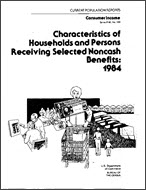Characteristics of Households and Persons Receiving Selected Noncash Benefits: 1984
Characteristics of Households and Persons Receiving Selected Noncash Benefits: 1984
Note
Estimates in this report are based on a sample that includes households from both the 1970 census-based sample design and the new 1980 census-based design. Since this overlap in the sample design does not permit the development of estimates for metropolitan, nonmetropolitan, farm, and nonfarm categories that are comparable to either the 1980 or 1970 census definitions, figures for these residence categories have been omitted. The estimates in this report for 1983 and 1984 reflect the introduction of new survey weighting procedures for the Spanish-origin population. See the section on revised survey procedures for a detailed explanation of these changes.
Introduction
This report contains data on the characteristics of households and persons receiving noncash benefits in 1984. These data were obtained from the March 1985 Current Population Survey (CPS) conducted by the Bureau of the Census. Noncash benefits can be defined as benefits received in a form other than money that serve to enhance or improve the economic well-being of the recipient. Data collection in March 1985 concentrated on two major categories of noncash benefits: those usually defined as public transfers and employer- or union-provided benefits to employees. In the area of public noncash transfers, the survey covered. the following programs: the Food Stamp Program, the National School Lunch Program, public and other subsidized rental housing, Medicare health insurance, Medicaid health insurance, and CHAMPUS, VA, or military health insurance. Data were collected for two types of employer- or union-provided noncash benefits: pension plans and group health insurance plans. The income data in this report are limited to money income before the payment of Federal, State, local, or Social Security (FICA) taxes or any other deductions. They do not include the monetary value of any noncash benefits these households received.
A Note on Language
Census statistics date back to 1790 and reflect the growth and change of the United States. Past census reports contain some terms that today’s readers may consider obsolete and inappropriate. As part of our goal to be open and transparent with the public, we are improving access to all Census Bureau original publications and statistics, which serve as a guide to the nation's history.
Others in Series
Publication
Publication
Publication




